Table of contents
Performance date: 6 juillet 2019 - First performance
Documentation date: 22 juillet 2019
Version state
Valid
Validation date: 17 décembre 2019
Executions dates of this version
- 6 juillet 2019,
Version documentalist
- muller (Augustin.Muller@ircam.fr)
Version realisation
- Augustin Muller (Computer Music Designer)
- Adam Maor (Composer)
- Serge Lacourt (Sound engineer)
Version length
60 sUpgrade Motivation
Creation Version. Festival d'Aix en Provence - Théâtre du Jeu de Paume
Comment
United Instruments of Lucilin. Cond. Elena Schwartz.
Keyboard Player : Pascal Meyer
tested and validated by Pascal Meyer
No other version available
Electronic equipment list
Computer Music Equipment
-
1 Retina - Apple Laptops
(Apple)
With Live 10.1 & Max 8 -
1 iPad - Tablets
(Apple)
with lemur, for monitoring -
1 Fireface 802 - Sound Board
(RME)
6 outputs -
1 MIDI controller - MIDI Controllers
Korg Nano Kontrol was used -
1 MIDI Keyboard - MIDI Keyboard
88 keys with pgm change, sustain, expression pedal, modwheel and pitchbend -
1 MIDI interface - MIDI Interfaces
to connext the keyboard and the controller
Audio Equipment
-
6 Loudspeaker - Loudspeakers
3 layers of stereo.
Work related information
Premiere
- None,
Realisation
- Augustin Muller
Work length
- 1 h 10 mn
Useful links on Brahms
- Les Mille Endormis opéra pour quatre voix, ensemble et électronique live (2019), 1h10mn
- Adam Maor
| File | Author(s) | Comment | |
|---|---|---|---|
| Download [1,7 Mio] | Readme SL1000 checklist | A Muller | quick checklist |
| Download [7,9 Kio] | Other SL1000_lemur | for ipad | |
| Download [1,6 Gio] | Ableton session SL1000_SESSION | A Muller | Live 10.1 session with everything |
Instructions
Les Mille Endormis - Documentation (2019)
Audio Config
6 audio outputs : 1-2 stereo Pit, 3-4 stereo Front, 5-6 Stereo Backstage
0 audio inputs
System installation
Les Mille Endormis electronic part consist in a Live 10.1 session using Max For Live devices. Max 8 is mandatory (mc.~ usage)
Software
Just open the live session. Enerything is there. Setting was FS: 44100, IO Buffer : 512. ( Should be ok @ 48k !)
Midi
Keyboard:
channel 1
Modwheel on Ctl 1
Expression Pedal on Ctl 7
Nanokontrol
- on channel 16
Lemur
For Lemur, just install the provided project. Connexion in usb was used. The ipad is used for monitoring only.
Spare
For the spare, a special routing was made in the iconnect, to send both the kehboard and the nanokontrol out of the midi din 1
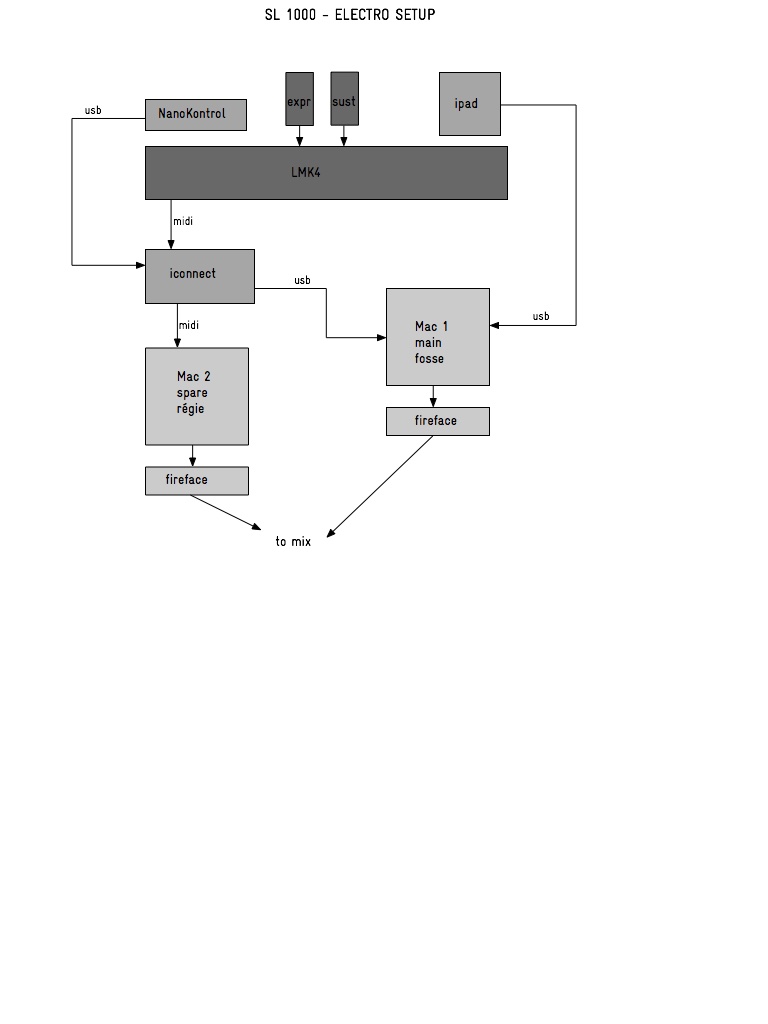
System calibration and tests
Set the levels of the different pair of loudspeaker such as the presence in the pit is comparable to an instrument. The front (face) lvl should be balanced with the pit. For the backstage, try to find a position of speakers that renders an effect of depth but still with correct coverage. In Jeu de Paume, 2 pairs of speakers were used for this layer, one hanged from the top, the other on stands. Beware of the level as this is close to the singers.
Initialization routine
See quick checklist provided for the total setup. Once everything is connected :
Check soundcard
Launch Lemur Daemon and connect (i0/o0, o0/i0)
Launch the live session
check preferences (IO devices & Midi)
check every pgm
Session presentation
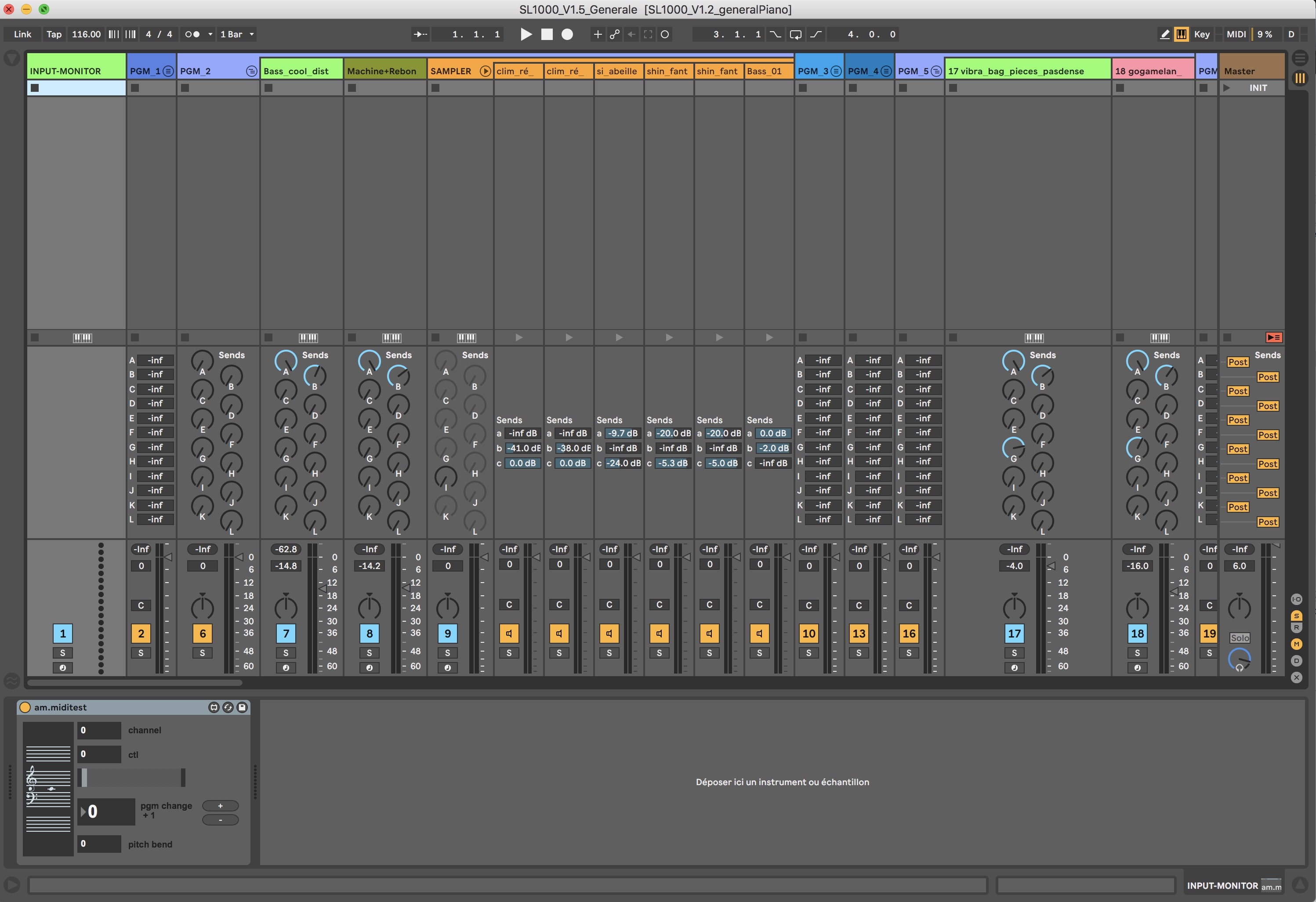
The session is organized in the mixer view (no use of the time line)
The physical midi input goes in the first track (Input-Monitor).
The physical audio outputs come from the return tracks (no use of the master track)
The volume pedal of the keyboard controls the volume of the first 3 stereo outputs return tracks (A B C, keyboards). The files go in the same physical outputs but without volume control (D E F). G H I are used for effects. J K L are the last outputs for effects and optional direct outs. The order is always the same :
1-2 => Pit
3-4 => Face
5-6 => Backstage
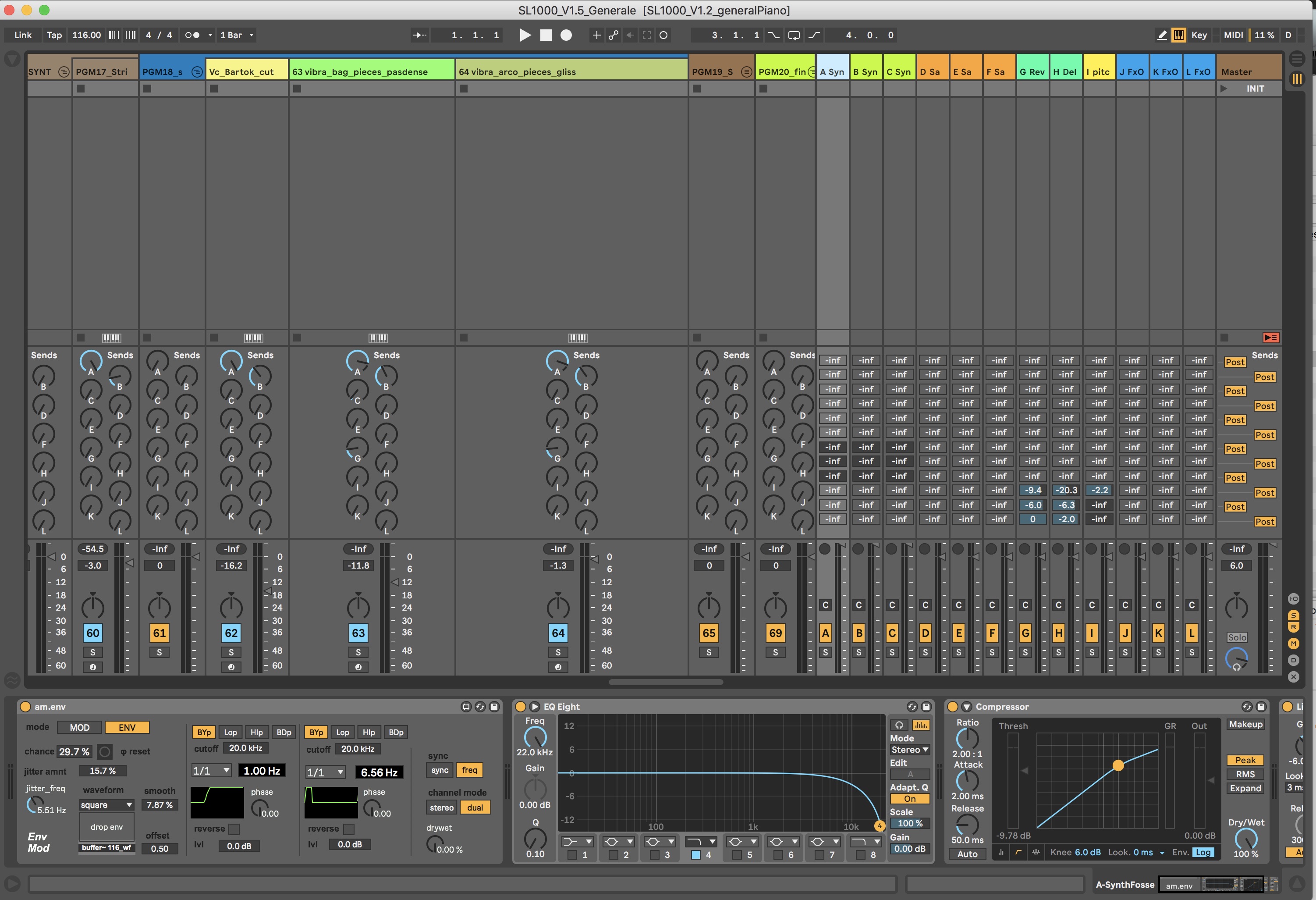
Each group gathers the tracks composing a program. The levels of the tracks can be set by the player to adjust balance between programs.
The NanoKontrol provides access to effects applied to the outputs A B & C (keyboards) :
filter (freq and reso)
granulation (chance / freq /drywet)
It enables also some effect sends added to the outputs :
reverb
pitched delay
freqshift (drywet)
Midi Interface
Keyboard:
channel 1
Modwheel on Ctl 1
Expression Pedal on Ctl 7
Nanokontrol
- on channel 16
In Live prefs, the keyboard, Nano Kontrol & Lemur must be enabled in “track” and “remote”. See checlist for an screenshit of the midi prefs.
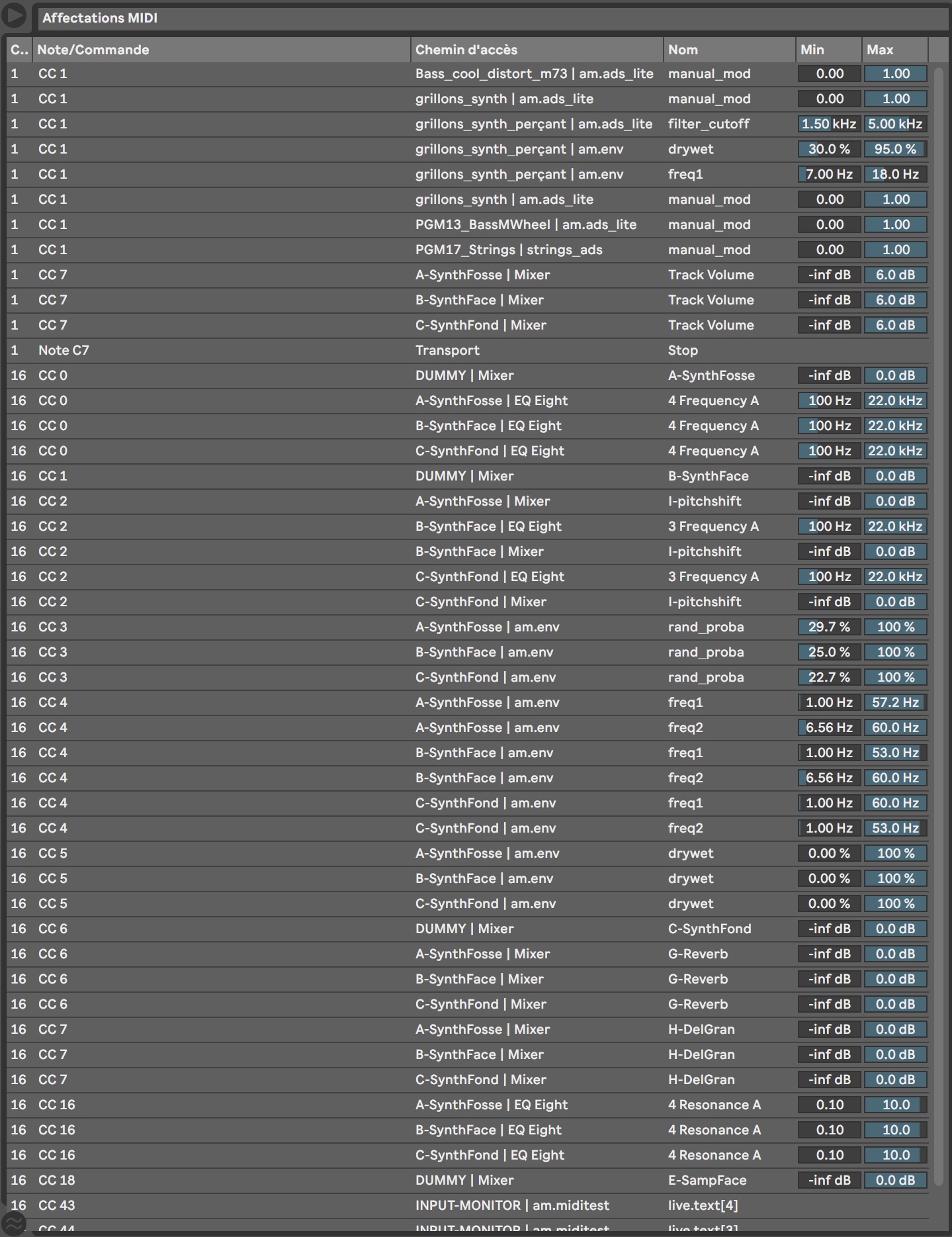
Performance notes
General : Les Mille Endormis features 3 main strategies for electronics :
Keyboard Sounds
Mostly play in the pit
quasi-instrumental sounds
mixed with the instruments
Textures (shin_fant, synth …)
more diffuse in the space
synthetic sounds
modified with the nanokontrol (gran, filter …)
Soundfiles
more in the backstage
triggered with no live control on the volume or color
The levels of soundfiles have to be set in the test phase then are not modified during the performance.
See the score for details.
The Opera is lightly amplified. All singers and instruments are equipped with microphones.
As acoustic balance is achievable, light amplification of the instruments is necessary for effect and blending, and the voice of the bass singer must be at some times (sc 8 …) reinforced in the backstage speakers to give a low, cavernous voice impression.
Here a view of th pit. Notive the placement of the Right speakers at the height of the keyboardist. The other one is on the floor next to the accordeon.
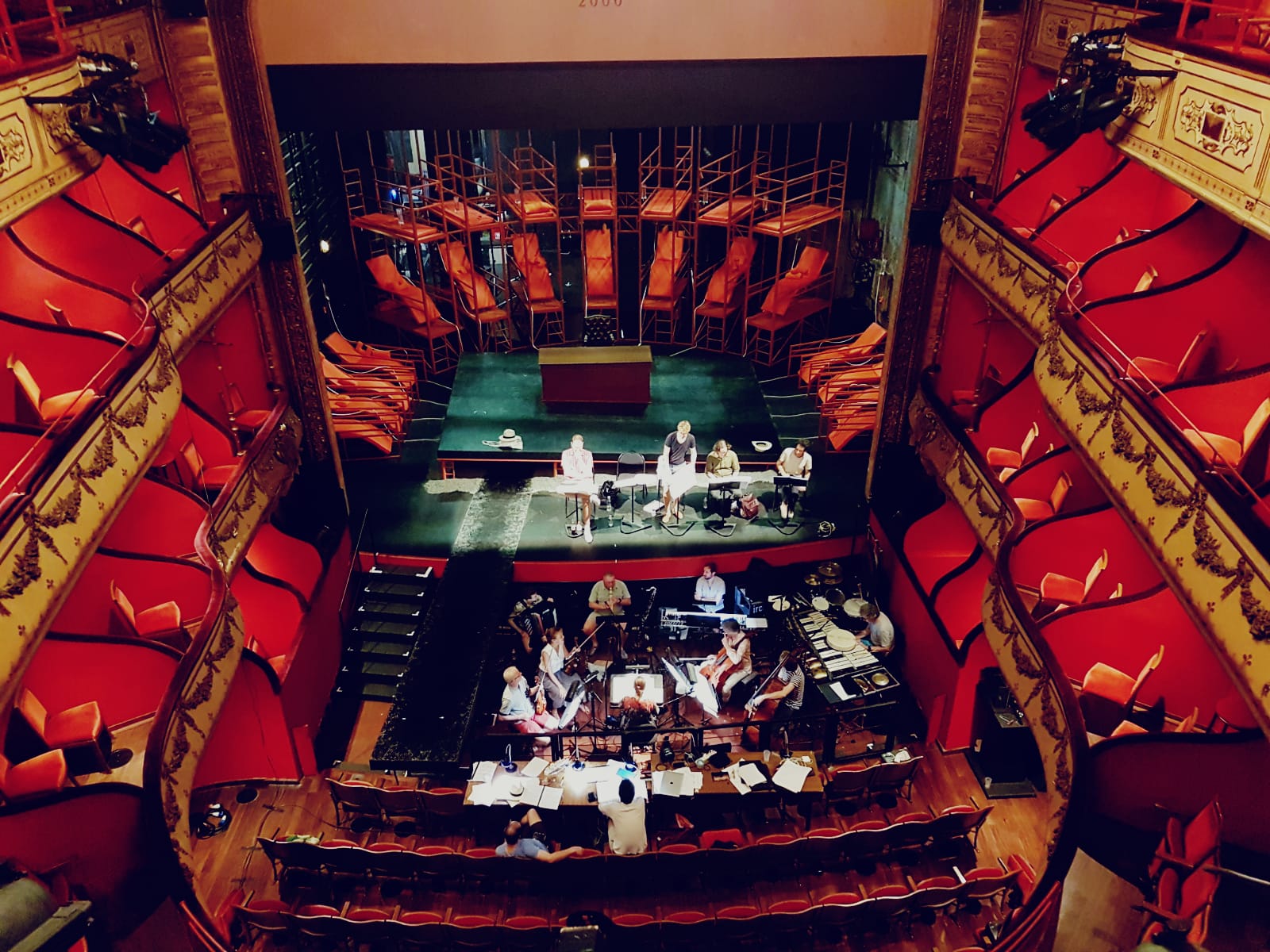
© IRCAM

This documentation is licensed under a Creative Commons Attribution-NonCommercial-NoDerivatives 4.0 International License.
Version documentation creation date: 22 juillet 2019 14:25, update date: 6 mai 2021 15:09